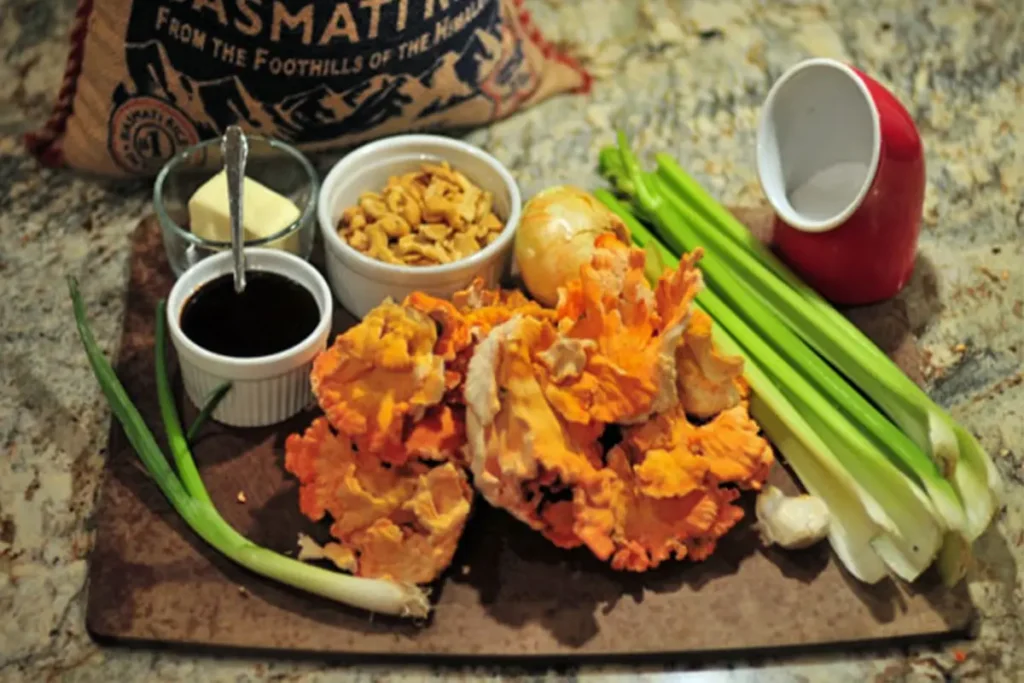Discovering the Best Ways to Enjoy Chicken of the Woods
“In the realm of culinary adventures, the question ‘What’s the best way to eat Chicken of the Woods?’ often arises among both seasoned foragers and curious food enthusiasts. This unique and flavorful mushroom, known for its striking appearance and chicken-like taste, offers a world of culinary possibilities. In this comprehensive guide, we delve into the various methods of preparing and enjoying Chicken of the Woods, exploring everything from its nutritional benefits to delicious recipes that highlight its versatility.
Exploring Various Cooking Methods for Chicken of the Woods
Chicken of the Woods, a mushroom that’s as intriguing as its name, is not your average fungi. This large, vibrant mushroom, scientifically known as Laetiporus sulphureus, is a culinary delight found on decaying trees and logs. Its striking appearance and chicken-like flavor make it a sought-after ingredient in various dishes.
Historical and Cultural Significance
Chicken of the Woods has a rich tapestry of historical and cultural significance. Revered for centuries in various cultures, this mushroom has been a staple in traditional medicine and regional cuisines. In European folklore, it was often associated with woodland spirits and was thought to bring good fortune to those who found it. Native American tribes used it for its medicinal properties, particularly for its anti-inflammatory and antimicrobial effects. Over time, its popularity has grown, especially among modern foragers and chefs who value its unique flavor and texture.
Mastering the Art of Preparing Chicken of the Woods
Diving into the scientific world, Chicken of the Woods belongs to the fungus kingdom. It thrives on hardwood trees like oaks and cherry trees, playing a crucial role in the ecosystem by decomposing old trees and recycling nutrients. This mushroom is primarily found in Europe and North America, with similar species in East Asia.
Appearance and Identification
Spotting Chicken of the Woods is like finding a treasure in the woods. Young mushrooms boast a radiant orange or yellow color, resembling shelves stuck to tree sides. They’re soft to the touch, with a suede-like texture. As they age, their color fades to a lighter yellow or tan, and they become more brittle. It’s essential to identify them correctly, as there are similar, slightly toxic species. When in doubt, consult an expert or err on the side of caution.
In the next section, we’ll explore the nutritional profile and health benefits of this fascinating mushroom, shedding light on why it’s not just a tasty treat but also a healthy addition to your diet.
Culinary Adventures with Chicken of the Woods
Tasty Chicken of the Woods Recipes for Every Palate
Chicken of the Woods isn’t just a treat for the taste buds; it’s a nutritional powerhouse too. This mushroom is low in calories and fat, making it an excellent choice for health-conscious individuals. It’s packed with protein, accounting for about 10% of its composition, and is rich in carbohydrates, providing the energy we need. Its unique nutritional profile makes it a fantastic meat substitute, especially for those following a plant-based diet.
How to Prepare Chicken of the Woods: Tips and Tricks
When considering ‘What’s the best way to eat Chicken of the Woods?’, it’s also important to understand its nutritional value and health benefits. This mushroom contains antioxidants like flavonoids and phenols, which help combat free radicals in the body. These antioxidants are known for their potential to reduce the risk of chronic diseases. Furthermore, the polysaccharides found in Chicken of the Woods may have tumor-fighting properties, encouraging the immune system to act against tumors and possibly causing tumor cell death. There’s also evidence suggesting that it can reduce inflammation, making it a valuable addition to a healthy diet.
Potential Side Effects and Allergies
While Chicken of the Woods is generally safe to eat, it’s important to note that the raw mushroom can cause gastrointestinal issues in some people. Also, a small fraction of individuals might experience allergic reactions. It’s crucial to cook this mushroom thoroughly to avoid any adverse effects. As always, if you’re trying it for the first time, start with a small amount to ensure you don’t have any sensitivities.
Nutritional Analysis in Depth
A deeper dive into the nutritional profile of Chicken of the Woods reveals its impressive array of vitamins and minerals. It is a good source of dietary fiber, protein, and contains negligible amounts of fat. Rich in Vitamin C and potassium, it also boasts a variety of B vitamins. The mushroom’s unique compounds, such as polysaccharides and antioxidants, contribute to its health benefits, including immune support and anti-inflammatory properties. Compared to other mushrooms, Chicken of the Woods stands out for its higher protein content and distinct nutritional composition.
Incorporating Chicken of the Woods into Different Diets
Chicken of the Woods is a versatile ingredient that can be incorporated into various diets. For vegetarians and vegans, it’s an excellent meat substitute, providing a hearty texture and flavor to dishes. Gluten-free enthusiasts can enjoy it as well, as the mushroom itself is naturally gluten-free. In low-carb diets, Chicken of the Woods can be used as a substitute for starchy ingredients, adding bulk and flavor to meals without the extra carbs. Its versatility makes it a valuable ingredient for those looking to diversify their diet while maintaining specific dietary requirements.
For a deeper understanding of the health benefits and nutritional value of Chicken of the Woods, check out this comprehensive WebMD article.
In the next part of our journey through the world of Chicken of the Woods, we’ll delve into the exciting realm of culinary uses and recipes. Get ready to discover how this versatile mushroom can transform your meals!
The Ultimate Guide to Eating Chicken of the Woods
Cooking Chicken of the Woods Perfectly: A Step-by-Step Guide
Before diving into cooking, it’s crucial to prepare Chicken of the Woods correctly. Start by thoroughly cleaning the mushroom to remove any dirt or debris. Younger mushrooms are ideal for their tenderness. If you encounter any tough or woody parts, it’s best to trim them away. Remember, this mushroom should always be cooked; consuming it raw can lead to stomach discomfort.
Innovative Recipes: Transforming Chicken of the Woods into Culinary Delights
Chicken of the Woods offers a culinary versatility that’s hard to match. Here are some techniques to bring out its best flavors:
- Sautéing: A classic method. Cook it in butter or olive oil until it’s tender and golden.
- Blanching: Ideal for soups and stews, blanching helps retain its texture.
- Baking: A great way to enjoy its meaty texture. Season and bake until it’s deliciously tender.
- Frying: For a crispy delight, fry the mushroom until it achieves a golden-brown crust.
Popular Recipes and Pairings
Answering the question, ‘What’s the best way to eat Chicken of the Woods?’, leads us to a variety of cooking methods and recipes that bring out its best qualities.. Here are some recipe ideas:
- Mushroom Risotto: Substitute traditional mushrooms with Chicken of the Woods for a rich and earthy flavor.
- Green Bean Casserole: Add it for an extra layer of texture and taste.
- Vegetarian “Chicken” Sandwich: Fry it and serve in a bun for a delightful twist on the classic chicken sandwich.
- Mushroom Nuggets: Cut into bite-sized pieces, bread, and fry for a fun and tasty snack.
If you’re looking for creative and delicious ways to cook Chicken of the Woods, this AllRecipes guide offers a variety of inspiring recipes.
These are just a few ways to incorporate Chicken of the Woods into your cooking. Its versatility makes it a delightful ingredient to experiment with, offering a range of possibilities for both novice cooks and seasoned chefs alike.
Preservation and Storage
Preserving Chicken of the Woods is key to enjoying its flavors year-round. Drying is a popular method, which involves slicing the mushroom and drying it in the sun, a dehydrator, or an oven at a low temperature. This method preserves its flavor and makes it easy to store for long periods. Freezing is another option, especially for retaining its texture – blanch the slices before freezing to maintain quality. Pickling Chicken of the Woods in vinegar with spices can also create a delightful condiment. When it’s time to use the preserved mushroom, rehydration or proper thawing will bring it back to its culinary glory.
Cooking Demonstrations and Techniques
Cooking Chicken of the Woods can be an exciting culinary adventure. For beginners, a simple sauté with garlic and herbs is a great way to start. Heat olive oil in a pan, add minced garlic, and cook until fragrant. Then, add the mushroom slices and sauté until they’re tender and golden brown. For a more advanced technique, try marinating the mushroom in a mixture of soy sauce, ginger, and garlic before grilling. This imparts a rich, savory flavor that’s perfect for a summer barbecue. Baking enthusiasts can stuff Chicken of the Woods with a mixture of cheese, breadcrumbs, and herbs, baking it until it’s deliciously crispy on the outside and meltingly tender inside.
Foraging and Sustainability
How to Forage Chicken of the Woods
Foraging for Chicken of the Woods is a delightful experience for nature enthusiasts and foodies alike. These mushrooms typically grow on dead or dying hardwood trees, such as oaks and cherry trees. The best time to forage is from late summer to early fall. When foraging, it’s crucial to positively identify the mushroom, as there are similar-looking species that can be toxic. Using a guidebook or a mobile app for identification is helpful, but the best practice is to forage with an experienced mushroom hunter, especially if you’re a beginner.
Sustainability and Environmental Impact
Sustainable foraging is essential when hunting for Chicken of the Woods. This involves taking only what you need and ensuring that you don’t harm the tree or the mycelium, the fungus’s root system. Sustainable practices help preserve the mushroom population and ensure that they continue to thrive in their natural habitat. Remember, foraging isn’t just about finding food; it’s about respecting and maintaining the balance of the ecosystem.
Mistaking Toxic Look-alikes
One of the risks of foraging for Chicken of the Woods is mistaking it for toxic look-alikes. Some species, particularly those growing on conifers, can be slightly toxic and cause adverse reactions. Symptoms can range from mild gastrointestinal distress to more severe reactions. Always be certain of your identification before consuming any wild mushrooms. When in doubt, it’s better to err on the side of caution and not consume the mushroom.
FAQs on Chicken of the Woods
Common Questions and Answers
Chicken of the Woods often sparks curiosity and questions, especially among those new to foraging or cooking with this unique mushroom. Here are some frequently asked questions to enhance your understanding and experience:
- Is Chicken of the Woods Safe to Eat?
- Yes, when properly identified and cooked, Chicken of the Woods is safe and enjoyable to eat. However, it’s important to note that the raw mushroom can cause gastrointestinal issues, so it should always be cooked.
- How Do I Identify Chicken of the Woods?
- Chicken of the Woods is identifiable by its large, shelf-like structure and vibrant orange or yellow color. It typically grows on hardwood trees. If you’re new to foraging, it’s advisable to consult a guidebook or an experienced forager to ensure correct identification.
- Can I Eat Chicken of the Woods Raw?
- It’s not recommended to eat Chicken of the Woods raw due to the potential for stomach upset. Cooking it not only makes it safer but also enhances its flavor and texture.
- Where Can I Find Chicken of the Woods?
- This mushroom is commonly found in Europe and North America, growing on dead or dying hardwood trees like oaks and cherry trees. The best time to forage for them is from late summer to early fall.
- What Does Chicken of the Woods Taste Like?
- Chicken of the Woods has a texture and flavor reminiscent of chicken, hence its name. It’s a popular meat substitute in various dishes due to its savory taste and substantial texture.
- Are There Any Look-alikes I Should Be Aware Of?
- Yes, there are some look-alikes that can be slightly toxic, especially those growing on conifers. Always ensure accurate identification before consuming any wild mushrooms.
Conclusion
In conclusion, Chicken of the Woods is not just a mushroom; it’s a culinary journey, a forager’s delight, and a nutritional treasure. From its vibrant appearance in the wild to its versatile uses in the kitchen, this fungus offers a unique experience for nature enthusiasts and food lovers alike. Its rich historical significance, coupled with its health benefits and sustainable foraging practices, make it a remarkable subject of interest. Whether you’re a seasoned forager, a gourmet chef, or simply a curious foodie, Chicken of the Woods presents a world of flavors and discoveries waiting to be explored. As we respect and appreciate the natural world, this mushroom serves as a reminder of the bountiful, yet delicate balance of our ecosystem.


